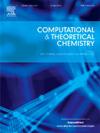Modeling electronic structure and charge transport properties of Tetrathienopyrrole-based hole-transporting materials: A DFT approach for enhanced photovoltaic efficiency towards efficient perovskite solar cells
IF 3
3区 化学
Q3 CHEMISTRY, PHYSICAL
引用次数: 0
Abstract
This quantum mechanical approach paved the way for fabricating highly stable hole-transporting materials for photovoltaic cells. This scheme involved the integration of acceptor terminal units through a thiophene spacer to the versatile symmetrical tetrathienopyrrole core connected to dimethoxytriphenylamine helix units, resulting in a series of six novel HTMs (DTT-1 to DTT-6). Comprehensive analysis of the energetics of energy levels (HOMO/LUMO), solvation energy, density of states (DOS), and stability of proposed HTMs were evaluated by systematically performing the quantum computation via (DFT) and (TD-DFT). The results revealed that fabricated HTMs (DTT-1 to DTT-6 unveiled stabilized HOMO levels approaching the edge with suitable HTM/perovskite energy level alignment, proposing exceptional charge extraction and high open circuit voltage. Photophysical analysis indicated that our fabricated HTMs revealed larger Stokes shift values (75 nm −150 nm) and transparency in the visible region, allowing full utilization of sunlight for the perovskite layer for photocurrent generation and enhanced spectral selectivity. The proposed HTMs showed smaller RE values ranging from 0.106 eV to 0.23 eV and greater transfer integral, signifying ultrafast hole mobility. Moreover, comparatively higher dipole moments (2.81 D-11.07 D) and higher negative solvation energies (−18.62 kcal/mol to −21.86 kcal/mol) suggested improved solubility and film-forming attributes. Hence, this study provides crucial insights into the deliberate and effective design of high-performance HTMs.

基于四噻吩吡咯的空穴传输材料的电子结构和电荷输运特性建模:一种提高光伏效率的DFT方法,用于高效钙钛矿太阳能电池
这种量子力学方法为制造高度稳定的光电电池空穴传输材料铺平了道路。该方案涉及通过噻吩间隔剂将受体末端单元整合到与二甲氧基三苯胺螺旋单元连接的多功能对称四噻吩吡啶核心,从而产生一系列六种新型HTMs (DTT-1至DTT-6)。通过(DFT)和(TD-DFT)系统地进行量子计算,对所提出的HTMs的能级(HOMO/LUMO)、溶剂化能、态密度(DOS)和稳定性进行了综合分析。结果表明,制备的HTMs (DTT-1至DTT-6)呈现出接近边缘的稳定HOMO能级,并具有合适的HTM/钙钛矿能级排列,具有优异的电荷提取和高开路电压。光物理分析表明,我们制备的HTMs具有较大的Stokes位移值(75 nm ~ 150 nm)和可见光区域的透明度,允许钙钛矿层充分利用太阳光产生光电流并增强光谱选择性。所制备的HTMs具有较小的RE值(0.106 eV ~ 0.23 eV)和较大的转移积分,表明其具有超快空穴迁移率。此外,较高的偶极矩(2.81 D-11.07 D)和较高的负溶剂化能(- 18.62 kcal/mol ~ - 21.86 kcal/mol)表明其溶解度和成膜特性有所改善。因此,本研究为高性能html的深思熟虑和有效设计提供了重要的见解。
本文章由计算机程序翻译,如有差异,请以英文原文为准。
求助全文
约1分钟内获得全文
求助全文
来源期刊

Computational and Theoretical Chemistry
CHEMISTRY, PHYSICAL-
CiteScore
4.20
自引率
10.70%
发文量
331
审稿时长
31 days
期刊介绍:
Computational and Theoretical Chemistry publishes high quality, original reports of significance in computational and theoretical chemistry including those that deal with problems of structure, properties, energetics, weak interactions, reaction mechanisms, catalysis, and reaction rates involving atoms, molecules, clusters, surfaces, and bulk matter.
 求助内容:
求助内容: 应助结果提醒方式:
应助结果提醒方式:


